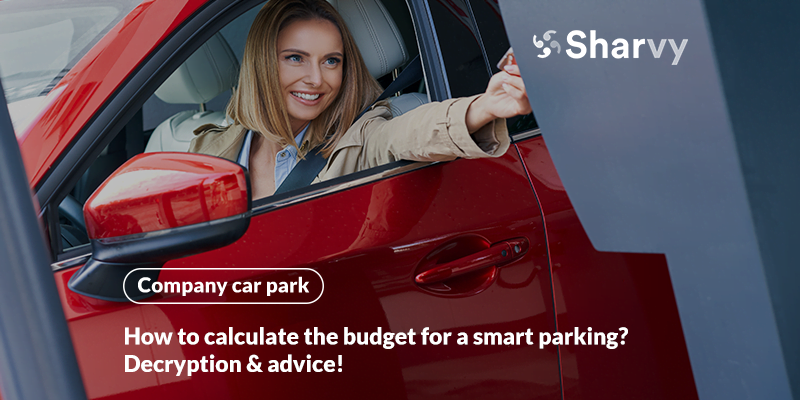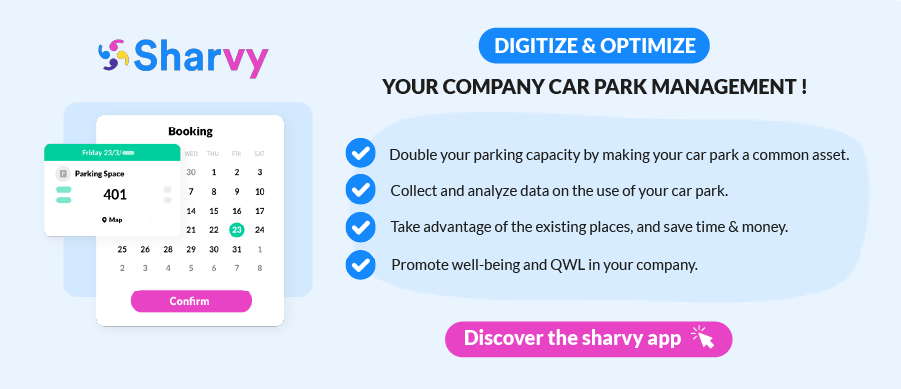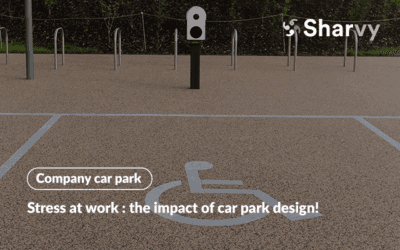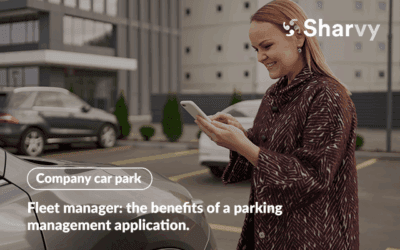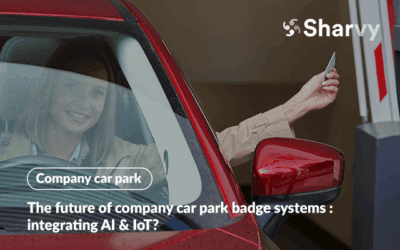In a professional context where efficiency & innovation are essential drivers of competitiveness, companies are constantly seeking to optimize their resources & improve the experience of their collaborators.
However, optimizing company car park often takes a back seat, wrongly so!
Especially since today, it becomes (almost) impossible for companies to offer a designated parking spot to each collaborator. Thus, they regularly face a situation where the demand for parking spaces far exceeds the available supply.
To address this situation, it is wise to resort to smart parking: an innovative solution still unknown to many companies! Smart parking provides efficient management of parking spaces through the integration of advanced technologies & dedicated mobile applications, like Sharvy.
Nevertheless, implementing smart parking within a company requires rigorous financial planning & a careful evaluation of costs. That’s why our article is here for you! Discover all our advice, the pitfalls to avoid, and the details of the costs to estimate right here.
A refresher: what is smart parking? Definition & objectives.
Smart parking (also known as “Intelligent parking” in English) transcends the traditional and passive management of company parking lots to embrace an active, intelligent, and connected approach.
This concept relies on New Information and Communication Technologies (NICT) as well as IoT solutions, to optimize the management of parking spaces, but also to enrich the user experience.
Consequently, a smart parking is characterized by:
- Sensors on each parking space to detect the presence of a vehicle.
- Sensors on each parking space to detect the presence of a vehicle.
- Access control to the parking lot, with automatic barrier opening.
- A license plate recognition system at the entrance of the parking lot.
- A digital solution facilitating the reservation & allocation of parking spaces.
- Dynamic signage panels guiding to available spaces.
The objective of smart parking? It is primarily to simplify access to parking in urban & peri-urban areas, while maximizing the use of existing parking spaces. Therefore, it aims to optimize the occupancy rate of the parking lot, while meeting the increasing demand of users, whether they are motorists, motorcyclists, or carpoolers.
What is the cost of smart parking? Decryption & cost details.
1. Rehabilitation of the company parking.
The costs related to the rehabilitation of the company parking vary according to several factors. Firstly, according to the extent of the modernization and, obviously, the size of the parking (in other words, the number of parking spaces).
In parallel, the rehabilitation of the parking will certainly generate a new layout for it, so an envelope intended for new signage including a variety of panels and markings designed to guide users, as well as to ensure safety, should be planned.
This includes directional signs indicating the entries and exits of the parking lot (if these are modified), as well as regulatory signs such as those reserved for people with reduced mobility, spaces equipped with a charging points for electric vehicles, and loading zones.
Ground markings are also essential, delineating parking spaces, traffic lanes, pedestrian crossings, and safety zones. On average, this costs between €5 and €10 per linear meter.
Generally, for a medium-sized parking lot (50 to 100 parking spaces), costs can range from €5,000 to €10,000. These costs are estimates. They can vary depending on local specifics, technical requirements, and labor costs. For an accurate budget, it is recommended to consult experts in smart parking management.
2. Access control solutions.
The reception & user experience is an essential element that must not be neglected in the context of smart parking. The goal is to no longer see queues at the parking barriers, as well as difficult & slow identification methods.
Therefore, this is also a budget to consider if you wish to improve the parking experience, as well as the collaborator experience.
Note that there are numerous access control solutions & that costs vary significantly. Moreover, beyond the initial purchase cost, you must take into account the maintenance costs, upgrading, and integration of the solution.
However, note that there are 3 main parking access control solutions:
- License plate recognition cameras: to be preferred if you wish to streamline traffic around your parking. As an authorized vehicle approaches the parking lot, the security barrier opens automatically. Users do not waste time searching for their RFID badges/cards & queues at the barriers become rare. However, the technology behind a license plate recognition camera is not available to all companies! Its purchase (on average €1,800) and installation have a certain cost.
- RFID card and badge readers: to be preferred if your budget is more limited (average €4 to €8 per badge) and if you rent spaces in a public parking, as this is the access control choice regularly chosen by landlords.
- IoT module: to be preferred if you wish to digitize the journey of your collaborators & visitors. The cost remains reasonable (on average €400 per IoT module). This module is connected to the automation of the barrier and the gate, and the user’s smartphone becomes a real remote control that can open the gate and the security barrier on demand through a dedicated app, like Sharvy.
3. Optimization of traffic within a smart parking.
Often, to improve the flow of vehicles within the parking, place guidance systems are integrated during the parking rehabilitation phase.
Thanks to these devices, the motorist is guided from their entrance into the parking lot by signs with light indicators directing them to available spaces and indicating in real time the number of spaces available in the different zones.
These indicators are generally connected to presence sensors indicating the occupation status of each space. They allow motorists to avoid engaging in an aisle where there would be no space available.
In parallel, and always with the aim of improving circulation within the parking lot, intelligent management of entrances and exits is adopted.
Guidance and optimization systems can cost between €150 and €500 per parking space.
4. Le logiciel de Parking Management.
In the context of smart parking, adopting Parking Management software is crucial.
This involves automating and optimizing the management of parking for companies of all sizes (small businesses, SMEs, medium-sized enterprises, large enterprises, and multinationals).
In other words, it allows employees to reserve parking based on their vehicle type (electric and hybrid rechargeable, two-wheelers, etc.). In parallel, the allocation of parking spaces is automated, the management of incidents and access control is facilitated, and most importantly, the occupancy of the parking is optimized.
Moreover, by digitizing the management of their parking(s), companies can collect, interpret, and monitor the evolution of various data (parking occupancy statistics, history of employee activities, etc.) which will evidently enable them to make the right decisions regarding its management, to energize and improve the parking experience for users.
Sharvy, for example, is one of the pioneers in this type of software. Today, the solution has more than 60,000 daily users worldwide! And importantly, more than 96% of requests are satisfied on the application.
Regarding the cost of such a solution, it will depend on your needs. For example, for managing smart parking, the price range is between €2 and €4 excl. VAT per space & per month. Note that by adopting Parking Management software, you are no longer constrained to rely on presence sensors indicating the status of parking occupancy, since all this information will be available from the app.
For more information about the Sharvy solution & its prices, do not hesitate to request a demonstration of the solution.
What ROI can be expected from smart parking?
Beyond the initial costs of creating a smart parking lot, let’s now see how it can contribute to the economic performance of your business, both by improving revenue and by allowing for the reduction of other cost items.
From a less accounting-focused and more empirical perspective, let’s see how it can improve your environmental balance sheet, by enhancing your brand image and the well-being at work of your collaborators.
1. An alternative to expanding your parking.
One of the main reasons companies invest in additional parking spaces is primarily: the lack of parking and the problems that arise for collaborators.
Many organizations observe a clear imbalance between the supply of available parking spaces and user demand. In such cases, the number of users often (significantly) exceeds the number of available parking spaces, which inevitably leads to situations of congestion, frustration, and (sometimes) non-compliance with the rules established within your company parking lot.
Smart parking is one of the best solutions to this situation. Indeed, rather than investing headlong into additional parking spaces, and correspondingly, by relatively costly works related to the expansion of your parking, consider this alternative within your company.
For example, be aware that on average, 10% of collaborators are absent each day, for various reasons: remote work, business trips, etc. In correlation, it’s at least 1 to 2 days per week where they will not use the company parking.
Add to this the 25 days per year (at minimum), when collaborators are on vacation, and they will not use the company parking (nor their designated spaces).
In total, there will be about 100 to 120 days per year when your collaborators will not use the company parking, which is nearly 1/3 of the working time!
To address this situation, opt for a Smart Parking software, like Sharvy, which communicates with your HRIS software, such as Lucca. Thanks to this type of API, the application can automatically free up and make available (only during their absence) the parking space of the titular collaborator to other collaborators (non-holders of a parking space). In other words, during their days of remote work, business trips, etc.
Beyond the savings you achieve by not building new parking areas, you can even realize savings by terminating some of your rental parking spaces. In this case, the gain is immediate!
2. A new source of revenue, thanks to smart parking.
By rehabilitating and modernizing your company parking, you will likely be required to install electric charging stations on your parking lot, according to new regulatory obligations.
Consequently, by opting for a Smart Parking solution, not only can you improve the management and allocation of parking spaces, but you can also manage your shared charging stations.
While you certainly have the option to provide the charging stations deployed on your parking lot free of charge to your collaborators, you can also choose to charge your collaborators and visitors for charging, thus generating new revenue.
Beyond a significant financial advantage, one of the main benefits for your company in charging for charging is to avoid the phenomenon of “buffer vehicles.” This is a situation where vehicles remain parked and connected to free charging stations for long periods, thus blocking access to other users.
By charging for charging services, your company encourages a quicker rotation of vehicles and optimizes the use of its infrastructure.
Therefore, in addition to the potential development of the company’s revenue, managing and controlling your paid charging stations through a Smart Parking solution is a wise strategy to monetize your investments while promoting efficient resource management.
3. An employee experience conducive to retention.
Today, the uncertainty of finding parking, coupled with the time spent searching for a spot, and the daily stress this generates, weigh on your collaborators’ ability to adhere to their schedules, as well as their motivation to come to the site. Moreover, this is never a good omen to start a day.
As a result, company parking directly influences the employee experience and can significantly reduce their loyalty to your organization.
However, by integrating digital technologies (through smart parking) in managing your parking lot, you can take into account the individual needs of each person and address recurring complaints about its management, by offering a positive parking experience.
These improvements contribute to the retention of your collaborators by increasing their satisfaction, as well as their commitment to your company.
In parallel, by adopting smart parking, you project an image of a company that cares about the daily life and well-being of its collaborators, which can also attract your (future) talents to your organization, since today parking can be a decisive factor in choosing a company.
4. Improving your environmental footprint.
It’s important to remember that today, home-to-work commutes constitute a significant portion of a company’s carbon footprint, accounting for between 10% and 40% (on average) of their total emissions.
Moreover, cars dominate long-distance travel but are also prevalent for short distances (less than 5 km). Additionally, the time required to find a parking spot represents not only lost time but also pollution emitted by the vehicle!
It is therefore crucial to rethink usage in order to reconcile the need to free up space with the parking needs of users. As a company, you can have a direct impact on this by adopting a Smart Parking solution, like Sharvy.
With this solution, your collaborators can obtain, ahead of their arrival on site, a global view of availability over the coming days in the parking lot and can thus anticipate their mobility (for example: favoring, whenever possible, a two-wheeler, if the parking is full).
By doing so, you encourage the rotation of the use of parking spaces, which leads to less reluctance from the holder to use public transport, as well as to favor soft mobility options. And this, without losing the use of their parking space, which promotes multimodality.
What are the pitfalls to avoid? Our examples & advice!
In conclusion
There is no doubt: implementing smart parking within a company represents a significant investment, with costs that can vary based on numerous factors such as the size of the installation, the initial state of the parking, and the technologies chosen.
That’s why a well-structured financial plan, as well as a careful assessment of the specific needs of your company, are essential to ensure the success of your project.
Have a question? Check the following FAQ!
What are the most commonly used technologies in smart parking?
The technologies most commonly used in smart parking include a combination of sensors, communication systems, and parking management software (such as Sharvy). At the heart of these systems are IoT (Internet of Things) sensors, which can be installed on the ground or on walls to detect the presence or absence of vehicles.
In parallel, intelligent cameras, equipped with license plate recognition capabilities, also play a crucial role by automating vehicle access and exit, as well as monitoring the security of your parking.
How long does it take to install a smart parking system?
The installation time obviously depends on the complexity and size of the parking area. Generally, it can take from a few weeks to several months.
For example, to install the Sharvy Smart Parking solution, you should plan for at least 3 to 4 weeks from the time our support team receives all the elements necessary to create the Sharvy space.
Subsequently, the deployment time of the solution varies according to the profile of the space to be created (technical specifications, installation of access control equipment, specific developments, etc.).
What are the recurring costs associated with a smart parking?
Recurring costs include equipment maintenance, software subscriptions, energy (especially for lighting and charging points), and any technology upgrades (LAPI cameras, IoT modules, etc.).
Can a smart parking be integrated into a multi-site management system?
Yes, it is entirely possible to integrate a smart car park into a multi-site management system, and this is even one of the strengths of these modern solutions.
Thanks to parking management software like Sharvy, you can control several car parks from a single interface, monitor their occupancy in real time and optimise the use of spaces across all your sites. This simplifies management enormously, especially for large companies, such as organisations spread over several locations.
What’s more, this overview means you can better anticipate needs, offer services tailored to users, and even reduce operational costs. A practical, efficient solution!
Can smart parking in businesses integrate rules similar to public parking?
Want to learn more? Check out our latest articles!
Stress at work : the impact of car park design!
How does company car park design affect workplace stress? Can it improve employees’ day-to-day well-being?
Fleet manager: the benefits of a parking management application.
How can a fleet manager improve car park management across company sites? The challenges & benefits of using a Parking Management app.
The future of company car park badge systems : integrating AI & IoT?
How are AI & IoT revolutionising badge systems for company car parks? Towards simpler, more secure and connected access.
Subscribe to our newsletter!
Resources
Contact us
+44 117 463 6990

